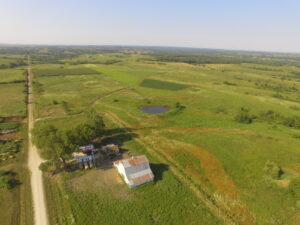Project Overview
Annual Reports
Information Products
Commodities
- Agronomic: grass (misc. perennial)
- Animals: bovine
Practices
- Animal Production: grazing management, grazing - continuous, range improvement
- Natural Resources/Environment: biodiversity, habitat enhancement, wildlife
- Sustainable Communities: social psychological indicators, environmental attitudes
Abstract:
Tall fescue (Schedonorus arundinaceus, syn. Festuca arundenacea, syn. Schedonorus phoenix) is an invasive grass with known negative effects on cattle health and hypothesized negative effects on ecological communities. Our project addresses these effects by examining the interrelated agricultural, ecological, and social dynamics of tall fescue in working Midwestern grasslands. Our goals were to evaluate (1) use of tall fescue by grazing cattle, (2) avian and arthropod community response to experimental changes in tall fescue cover, and (3) landowner capacity to remove tall fescue on private lands.
[caption id="attachment_555623" align="alignright" width="300"] A photo of cattle in the Grand River Grasslands. Taken by Jaime J. Coon during summer 2018.[/caption]
A photo of cattle in the Grand River Grasslands. Taken by Jaime J. Coon during summer 2018.[/caption]
Our study was conducted in the Grand River Grasslands of Ringgold County, Iowa and Harrison County, Missouri. This research has been ongoing since 2006, and the current SARE project utilizes both prior data and new data. Our first field season for this project took place May-Aug. 2016. During the field season, we collected data on cattle grazing preferences in response to tall fescue abundance (Goal 1). Results on foraging preferences demonstrated the potential economic benefits of tall fescue control for farmers. We also counted grassland birds, monitored nests of a grassland bird of conservation concern (dickcissel, Spiza americana), and collected arthropods on all study sites in order to elucidate the costs and benefits for wildlife of removing tall fescue (Goal 2). We also designed and mailed surveys to examine landowner willingness to remove tall fescue on their land (Goal 3). Results from the survey revealed barriers and opportunities for controlling tall fescue on private land.
This project was inspired in part by concurrent research completed by project participants S. Maresh Nelson, J. Coon, and J. Miller on the complex impacts of invasive plants on birds:
Nelson, SB, JJ Coon, CJ Duchardt, JD Fischer, SJ Halsey, AJ Kranz, CM Parker, SC Schneider, TM Swartz, JR Miller. 2017. Patterns and mechanisms of invasive plant impacts on North American birds: a systematic review. Biological Invasions, 19(5): 1547-1563. Link.
Research Conclusions:
[caption id="attachment_555622" align="alignright" width="300"] A photo exemplifying the mixed-use landscape found in the Grand River Grasslands. Photo taken by Timothy M. Swartz in summer 2017.[/caption]
A photo exemplifying the mixed-use landscape found in the Grand River Grasslands. Photo taken by Timothy M. Swartz in summer 2017.[/caption]
Using combined agricultural, ecological, and social approaches to explore invasive grass management has allowed us to identify synergies between agricultural and conservation goals. For example, we found that cattle restrict grazing on tall fescue when other forages are available, especially legumes. We also found that tall fescue reduced the nest survival of a grassland bird. These results indicate that there may be social-ecological co-benefits resulting from reducing tall fescue on pastures. In addition, we found that landowner decisions to manage non-native grasses are driven by social norms, access to resources, and personal norms related to a sense of personal responsibility or stewardship. We also found that controlling fescue using herbicide affects grassland bird species differently, with some sensitive species experiencing reductions in abundance one-year after herbicide application. Based on these results, we advise that landowners who wish to improve forage quality and increase habitat quality consider reducing fescue and other non-native plants in smaller patches to give refuge to those bird species while treated areas recover. In addition, given the potential for personal norms and stewardship values to influence behaviors related to invasive species, managers and researchers could use messaging that reinforces landowners’ existing sense of moral responsibility, reminding them that removing non-native grasses can help wildlife, cattle production, and scenic value in their communities.
Recommendations based on our results have been provided to managers, landowners, and researchers working in the Grand River Grasslands via numerous presentations at both academic conferences and landowner/agency meetings. We have also published several articles and a technical report that have been distributed to interested parties working in the study region and similar working landscapes, all of which are available online.
Project objectives:
Agricultural

- Improve understanding of relationships between tall fescue and cattle foraging
Ecological:
- Improve understanding of the impact of tall fescue abundance on ecological communities
- Improve understanding of the impact of tall fescue removal on ecological communities
Social:
- Understand potential barriers to and opportunities for invasive grass removal
- Longitudinal analysis showing change in attitudes (2007-2017)
- Enhance knowledge in the community about invasive species
Outreach:
- Increase interest in sustainable agriculture in a grassland context
- Increase literacy in areas of grassland ecology